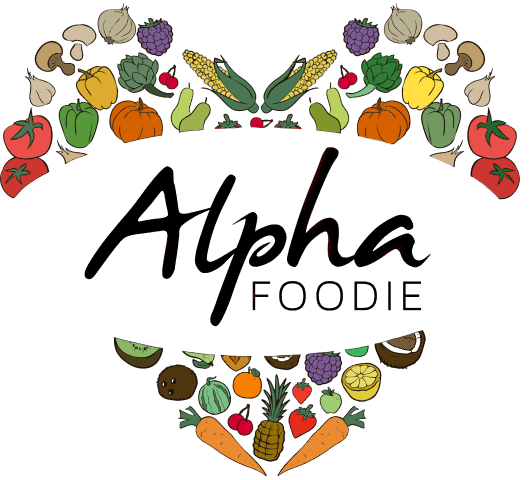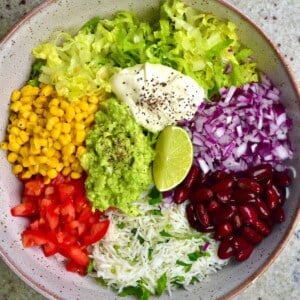This post may contain affiliate links. Please read our disclosure policy.
This delicious Korean bibimbap recipe combines rice, mushrooms, vegetables, eggs, and spicy gochujang sauce, making it the perfect meatless meal in a bowl.

Bibimbap is a Korean rice bowl dish that combines stir-fried rice with loads of veggies, umami mushrooms, and protein toppings. This quick vegetarian version is my favorite because I can use any leftover vegetables from the fridge and day-old rice. Below, I am sharing my top choices for add-ins, but you can easily customize the recipe to use what you have at hand. Plus, while I mostly make mine meatless, you could top your bowls with chicken or beef (like this Korean bulgogi beef).
Ingredients

- Cooked rice: Short-grain white rice is best. This recipe is also the perfect opportunity to use up any leftover cooked rice.
- Vegetables: Use carrots, cucumbers, spinach, bean sprouts, and scallions.
- Mushrooms: Shiitake mushrooms are most commonly used, but you can also use button or oyster mushrooms.
- Eggs: You will also need a bit of vegetable oil to fry them. For a vegan version, you can use tofu.
- Gochujang paste
- Rice vinegar
- Maple syrup
- Sesame oil
- Butter
- Tamari: Alternatively, use soy sauce
- Sesame seeds: Black or white, or a mix, to garnish.
- Kimchi: I love serving the bibimbap with some kimchi on the side but this is optional.
How to make bibimbap
Prepare the rice: I usually make the recipe with leftover rice. If you don’t have any, cook short-grain rice first and let it steam in the pot while preparing the rest of the ingredients.
Prepare Vegetables: You can prep them in any order you like. This is how I proceed with the recipe.
First, sautee the spinach in a dry skillet at low heat. When it wilts and becomes soft (it takes about 1 minute), season with a splash of sesame oil and tamari for extra flavor. Next, shred the carrots using a julienne peeler or a grater, and then lightly sauté them in sesame oil over medium heat until softened (another 1-2 minutes). Set them aside.
Thinly slice the cucumber and marinate it in a small bowl with rice vinegar and sesame oil for a tangy, nutty flavor. In the meantime, heat a small pot of water and blanch the bean sprouts for 1 minute, then drain. This will add a delicious crunch to the dish.

Slice the mushrooms and sauté them in a dry pan. Once they release their water, add the butter and a splash of tamari and rice vinegar and stir fry them for 1-2 minutes to enhance their rich umami flavor. Fry one egg per person with a bit of vegetable oil—cook for 3-4 minutes to achieve your perfect sunny-side-up eggs.
Finally, in a small bowl, make gochujang sauce by whisking the gochujang paste with maple syrup, sesame oil, and rice vinegar. Chop the scallions so they are ready for garnish.
Assemble the Bowls: Layer the rice, mushrooms, cucumbers, bean sprouts, carrots, and spinach in individual bowls. Then top with the fried eggs. Drizzle with gochujang sauce to taste and sprinkle with the chopped scallions and sesame seeds. Serve with kimchi on the side and extra sauce or your favorite side dishes. Enjoy!

More rice bowl recipes
If you try this dolsot bibimbap recipe, let me know how it goes in the comments below. I’d appreciate a recipe card rating and would love to see your recipe recreations – tag me on Instagram @Alphafoodie!

Vegetarian Bibimbap
Ingredients
- 15 oz cooked rice 3 cups
- 9 oz shiitake mushrooms 3 cups sliced
- 6 oz spinach 6 cups
- 4.1 oz bean sprouts 2 cups
- 4 oz carrots 2 cups shredded
- 4 oz cucumber 2 cups thinly sliced
- 4 stalks scallions chopped
- 3 eggs
- 3 Tbsp neutral oil to fry the eggs
- 2 Tbsp butter
- 1 Tbsp sesame oil divided
- 1 tsp rice vinegar divided
- 1 tsp tamari or soy sauce, divided
- 1/2 Tbsp sesame seeds black or white or mixed, to garnish
Gochujang Sauce
- 1/4 cup gochujang paste
- 2 Tbsp maple syrup
- 2 Tbsp sesame oil
- 3 Tbsp rice vinegar
Instructions
- If you don't have any leftover rice, cook it first and let it steam in the pot while preparing the rest of the ingredients.
- Sauté the spinach in a dry pan at low heat. When it wilts and becomes soft (it takes about 1 minute), season with 1 tsp sesame oil and 1/2 tsp tamari. Set aside.
- Shred the carrots using a julienne peeler or a grater, and then lightly sauté them in 1 tsp sesame oil until softened (another 1-2 minutes). Set aside.
- Thinly slice the cucumber and marinate it in a small bowl with 1/2 tsp rice vinegar and 1 tsp sesame oil. Set aside.
- Heat a small pot of water and blanch the bean sprouts for 1 minute. Drain and set aside.
- Slice the mushrooms and sauté them in a dry pan. Once they release their water, add the butter, 1/2 tsp tamari, and 1/2 tsp rice vinegar. Stir fry them for 1-2 minutes. Set aside.
- Fry the eggs with the vegetable oil over medium-low heat until the whites are fully set (3-4 minutes).
- In a small bowl, whisk the gochujang paste with maple syrup, sesame oil, and rice vinegar.
- Chop the scallions.
- Assemble the individual bowls. Layer the rice, mushrooms, cucumbers, bean sprouts, carrots, and spinach. Top with the fried egg. Drizzle with gochujang sauce to taste and top with the chopped scallions and sesame seeds. Serve with kimchi on the side and extra sauce if desired. Enjoy!
Video
Notes
Nutrition
Nutrition information is automatically calculated, so should only be used as an approximation.













Im going to make this minus the egg!!
Great! Let me know what you think 🙂